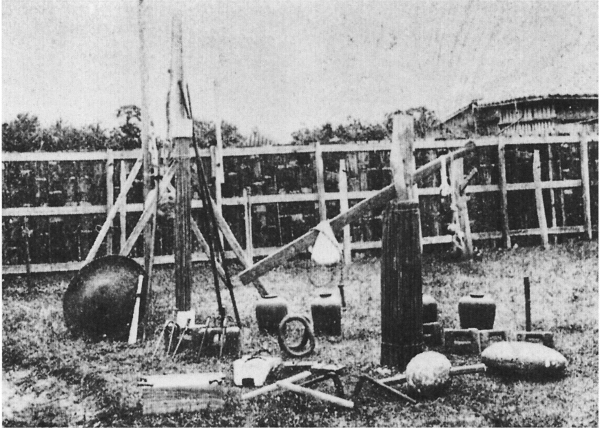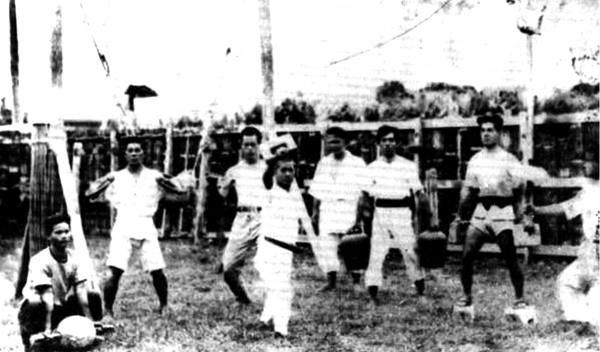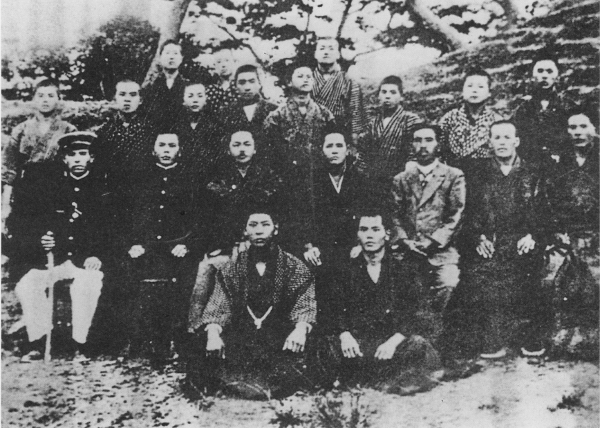Prelude
![]() n 1918/04 a meeting place was established at the house of Mabuni Kenwa in Shuri. Here the Karate Kenkyūkai (Karate Research Society, short KRS) was created with shuri-te proponents as its members: Mabuni Kenwa, Hanashiro Chōmo, Chibana Chōshin, Tokuda Anbun, Ōshiro Chōjo, Gusukuma Shinpan, Tokumura Seitō, Ishigawa Hōkō, and others.
n 1918/04 a meeting place was established at the house of Mabuni Kenwa in Shuri. Here the Karate Kenkyūkai (Karate Research Society, short KRS) was created with shuri-te proponents as its members: Mabuni Kenwa, Hanashiro Chōmo, Chibana Chōshin, Tokuda Anbun, Ōshiro Chōjo, Gusukuma Shinpan, Tokumura Seitō, Ishigawa Hōkō, and others.
This association is well contrasted by the Karate Kenkyū Kurabu (Karate Research Club, short KRC), established in 1923 or 1924 in Asahigaoka in Naha Wakasa as an open air practice place. Members were of naha-te: Miyagi Chōjun, Kyoda Jūhatsu, Shinzato Jin’an, Madanbashi Keiyō, Shiroma Kōki, and others.
The Okinawa Karate Kenkyū Kurabu
According to the testimony of Miyagi Chōjun’s disciple Nakaima Genkai (1908-1984), after the death of Miyagi’s teacher, Higashionna Kanryō (1853-1915), Miyagi said
“The current study of Karate is as we don’t have a light in the dark; it is like going blindly.”
In order to get the ball rolling again, Miyagi together with Nakaima visited various seniors from the karate circles to ask for instruction. It is said that Miyagi was keenly aware of the need for a collaborative research institute under participation of various masters of karate.
By merging the KRS and the KRC, in March 1925 the Okinawa Karate Kenkyū Kurabu (Okinawa Karate Research Club, short OKRC) came into being. It was established as an open-air practice era in the south of Naha Wakasa, obviously for the purpose of collaborative research of karate. Miyagi Chōjun (1888-1953) was the central figure of its establishment. He and Mabuni Kenwa (1889-1952) were appointed the responsible instructors and Motobu Chōyū (1857-1928) acted as its chairman. The OKRC became the first ever collaborative and systematic Karate research institute in Okinawa.
In 1925, Miyagi Chōjun borrowed funds from financiers, with his friend Go Kenki of White Crane boxing (hakutsuru kenpō) acting as a guarantor. In the following year (1926) a dōjō was completed in the rear of Mr. Kishimoto’s house in Wakasa. The dōjō area was about 50 square meters, and besides there was a garden of about 165 square meters, which was employed as well as an earthen floor dōjō. It was also equipped with various auxiliary practice tools, such as hanging makiwara (sagi-makiwara), strength-stone (chin-chīshi), stone padlocks (ishisashi) etc.

Auxiliary exercise (hojo undō) equipment of Karate-jutsu in the rear of Mabuni Kenwa’s house, 1925.
On the 1st and 15th day of the old lunar calendar, all instructors gathered in front of the alcove worshipping a hanging scroll depicting a “martial deity” (bujin) painted by master artist Yamada Shinzan. Afterwards – and while drinking awamori and the like – everything was crowned by a karate discussion.
With many of the various Karate masters of Okinawa at the time participating, it was a revolutionary organization. As for the participants, there are some variations in the literature, but the following are to be noted (alphabetical order):
- A certain Tomoyori (a police detective)
- Go Kenki (1887-1940)
- Gusukuma Shinpan (1890-1954)
- Hanashiro Chōmo (1869-1945)
- Kyan Chōtoku (1870-1945)
- Kyoda Jūhatsu (1887-1968)
- Mabuni Kenwa (1889-1952)
- Miyagi Chōjun
- Motobu Chōki (1870-1944)
- Motobu Chōyū
- Ōshiro Chōyo (1888-1939)
- Tabaru Taizō
- Teruya Kamesuke
- Yabu Kentsū (1866-1937)
Besides, Uehara Seikichi served as a donzel responsible for the tea ceremony, and Nakaima Genkai participated as a student.
As to the name, there are some differences in the representation according to author. The following names were found in literature:
- Okinawa Karate Kurabu
- Okinawa Karatejutsu Kenkyū Kurabu
- Okinawa Karate Kenkyū Kurabu
- Okinawa Karate Kenkyū Kurabu (different writing than previous)
- Okinawa Wakasa Kurabu
- Okinawa no Tī Kenkyū Kurabu
- Kurabu-gwā (common name)
Maybe there simply was no such thing as a formal official name.

Using auxiliary exercise (hojo undō) equipment of Karate-jutsu in the rear of Mabuni Kenwa’s house:
Madanbashi Keiyō (2nd from left), Shinzato Jin’an (4th from left), Chōjun Miyagi (5th from left)
From the beginning business was in deficit and the club gradually reached the end of its tether. With the death of Motobu Chōyū as the club’s chairman in the early Shōwa era, it was closed. The period of its closing is variously given in literature, spanning from 1927 to 1929.
With the inauguration of the Okinawa-ken Taiiku Kyōkai (Okinawa prefecture physical education association) on 1930/11/22, the idea of the OKRC was continued in the Karate branch of this new umbrella association. Active in it were Yabu Kentsū, Miyagi Chōjun, Ōshiro Chōjo and others.
Three years later in 1933/01/08, the Dai Nippon Butokukai became the organization authorized to control martial arts. And in 1936/12 the Okinawa-ken Karate-dō Shinkō Kyōkai (The Association for the Promotion of Karate-dō of Okinawa prefecture) was established for the same purpose.

The Okinawa Karate Kenkyū Kurabu: 2nd row from left: Higa Seikō (naha-te), Tabaru Taizō (unknown), Mabuni Kenwa (shuri-te), Miyagi Chōjun (naha-te), Kyoda Jūhatsu (naha-te), Shinzato Jin’an (naha-te), Madanbashi Keiyō (naha-te),
3rd row from left: Azama (later: Nanjō), Suki (naha-te), a certain person, Nakaima Genkai (naha-te), Yagi (unknown), Senaha (later Sakiyama), and Tatsutoku (naha-te). The others are unknown.
Biblio
- Hawai’i News, 1932; May 7, 1934.
- Higaonna 2001.
- Mabuni 2006.
- Miyagi 1936.
- Miyagi Takao 1976.
- Nakaima 1978.
- Okinawa Times, 31 January, 1926.
- Okinawa Karate Kobudō Jiten 2008.
- Uechi 1977.
- Uehara 1992.
- Yagi 2000.
© 2015, Andreas Quast. All rights reserved.